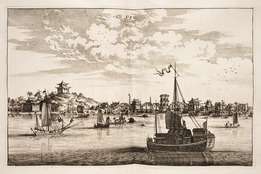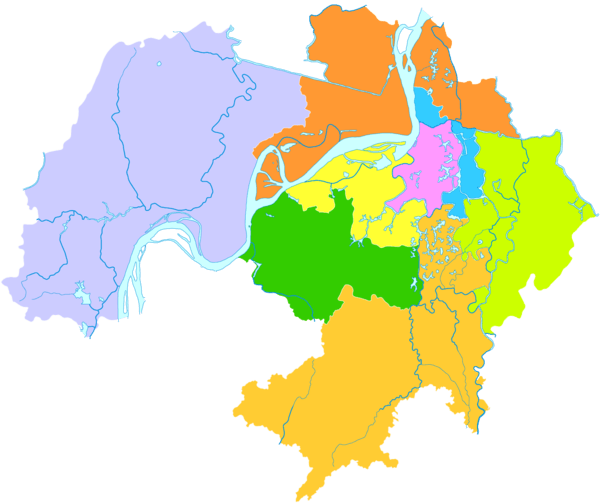Wuhu
| Wuhu 芜湖市 | |
|---|---|
| Prefecture-level city | |
 | |
.png) Location of Wuhu City jurisdiction in Anhui | |
| Country | China |
| Province | Anhui |
| County-level divisions | 8 |
| Municipal seat |
Jiujiang District (31°22′12″N 118°23′33″E / 31.37000°N 118.39250°E) |
| Government | |
| • CPC Secretary | / () |
| • Mayor | Pan Chaohui (潘朝晖) |
| • Deputy Mayor | Shi Dini |
| Area | |
| • Prefecture-level city | 5,988 km2 (2,312 sq mi) |
| • Urban | 1,292 km2 (499 sq mi) |
| • Metro | 972 km2 (375 sq mi) |
| Elevation | 7.9 m (26 ft) |
| Population (2010 census) | |
| • Prefecture-level city | 3,545,067 |
| • Density | 590/km2 (1,500/sq mi) |
| • Urban | 1,498,917 |
| • Urban density | 1,200/km2 (3,000/sq mi) |
| • Metro | 1,264,539 |
| • Metro density | 1,300/km2 (3,400/sq mi) |
| Time zone | China Standard (UTC+8) |
| Area code(s) | 0553 |
| GDP (2015) | ¥245.7 billion |
| GDP per capita | ¥67,592 |
| License Plate Prefix | 皖B |
| Website | http://www.wuhu.gov.cn/ |

Wuhu (simplified Chinese: 芜湖; traditional Chinese: 蕪湖; pinyin: Wúhú; literally "Weedy Lake") is a prefecture-level city in southeastern Anhui province, China. Sitting on the southeast bank of the Yangtze River, Wuhu borders Xuancheng to the southeast, Chizhou and Tongling to the southwest, Hefei to the northwest, Ma'anshan to the northeast, and the province of Jiangsu to the east, and is approximately 90 km (56 mi) southwest of Nanjing. Its population was 3,545,067 inhabitants at the 2010 census whom 1,264,539 in the built-up (or metro) area made of 3 out of 4 urban districts (all but Sanshan not yet continuously urbanized).
Administration
The prefecture-level city of Wuhu administers 8 county-level divisions, including 4 districts and 4 counties.
- Sanshan District(三山区)
- Yijiang District(弋江区)
- Jinghu District(镜湖区)
- Jiujiang District(鸠江区)
- Wuhu County(芜湖县)
- Fanchang County(繁昌县)
- Nanling County(南陵县)
- Wuwei County(无为县)
| Map | |||||
|---|---|---|---|---|---|
Demographics
By the end of 2011, the total population was estimated to be 3,842,100,of whom 1,450,000 live in the 4 urban districts and the others live in the counties. Vast majority of the local population are Han Chinese, though there are some Muslim Hui people as minorities. Jiang-Huai Mandarin, a branch of Mandarin Chinese, was widely spoken in urban area, while some people in the counties spoke Wu Chinese. Putonghua, or Standard Mandarin was commonly used in this area.
History
Wuhu is known to have been inhabited since at least 770 BCE. It became a strategically important town during the Three Kingdoms period (220-280 AD), when it was controlled by the Eastern Wu. At this time it was known as Jiuzi (Chiu-tzu 鸠兹). Under the Ming dynasty, Wuhu developed into a major commercial center and river port and since that time has been known as a center of the rice trade.
In 1644, the Hongguang Emperor (better known as the Prince of Fu), one of the last emperors of the Ming Dynasty, was captured by forces of the new Qing Dynasty in Wuhu. The city became a treaty port in 1876 and has remained a commercial center since that time. The city's Roman Catholic cathedral, St. Joseph's Cathedral (圣若瑟主教座堂), dates from this time. Most of the downtown area alongside the Yangtze River was ceded in the British concession.
Trade in rice, wood, and tea flourished at Wuhu until the Warlord Era of the 1920s and 1930s, when bandits were active in the area.
At the beginning of the Second Sino-Japanese War, part of the Second World War, Wuhu was occupied by Japan on December 10, 1937. This was a prelude to the Battle of Nanjing, ending in the Nanjing Massacre. Under Japanese occupation, Chinese resistance fighters hid in the lakes around Wuhu by submerging themselves and breathing through reeds.
Major industries began to be developed in Wuhu after the Second World War, with the development of the textile industry, shipbuilding, and paper mills. Despite this, Wuhu had been lagging behind Ma'anshan and Tongling in industrial production for decades after the establishment of the China, and remained primarily a commercial center for trade in rice, silk, cotton, tea, wheat and eggs. However, with recent years' economic rise, Wuhu has become a hub for manufacturing in the area.
Economy
The city is the second largest economy in Anhui, after Hefei, the provincial capital. In 2011, Wuhu’s GDP reached RMB 165.8 billion, an increase of 16.0% over the previous year. Its per capita GDP was RMB 47,028, with a year-on-year rise of 15.3%.[1]
Wuhu Economic &Technological Development Area in the north of the city launched in 1993 is one of the first state-level economic & technological development area in Anhui province, also has the only export processing zone in the province.[2] Chery Automobile and Anhui Conch Cement Company are both headquartered in this development area.
Wuhu is the fifth largest port alongside Yangtze River. Yuxikou Pier is the largest inland river coal harbor in China.
Transportation
Wuhu has one Yangtze River crossing—the Wuhu Yangtze River Bridge, opened in 2000, carries the G5011 Wuhu–Hefei Expressway and Huainan Railway.
Rail
Wuhu is served by the Anhui–Jiangxi, Nanjing–Tongling and Huainan Railways.
Culture
The great poet Li Bai spent his late life in Wuhu, it is said, due to its striking landscape. Li Bai was born in a Central Asian town and raised in the southwestern China. Xie Tiao, one of the most distinctive Six Dynasty poets whom he greatly admired, left many poems when holding positions here.
In the Tang dynasty (619-907), the poet Du Mu wrote a famous poem Thoughts on Staying Again at Wuhu. A factory in Wuhu carries on the local craft of making wrought iron pictures. Other local handicrafts are embossed lacquerware and rice straw pith patchwork. A famous stone tablet in Wuhu recording local events of the Song dynasty period (ca. 1000 AD) is considered to be a masterpiece of the renowned calligrapher Mi Fu. In the Western world, Wuhu is now known as the home city to many adopted Chinese children.
Folklore
An itinerant blacksmith named Tang Tianchi is reputed to have invented the wrought-iron picture in Wuhu, when a painter whom he admired chided him, "You will never make pictures by beating iron."
Another blacksmith of the Spring and Autumn period (770-476 BC) named Gan Jiang was famous for sword making. Zhe Shan (Reddish Brown Hill) is said to get its colour from the flames of Gan Jiang's furnace. Shen Shan (Sacred Hill) is the legendary location of his sword grinding rock and tempering pool.
Cuisine
Wuhu and Anqing are noted centers of the Yanjiang cuisine. It specializes in freshwater fish and poultry, and features special techniques of chopping, shaping, and colouring. The flavour of Yanjiang dishes is often enhanced by sweetening and smoking.
Tourism
- Mirror Lake (镜湖)
- Jiuzi Plaza (鸠兹广场)
- Yangtze Riverside Park (滨江公园)
- Mount Zhe, a hill park (赭山)
- Wuhu Olympic Stadium (奥林匹克体育馆)
- Yangtze River Bridge Crossing (长江大桥)
- Fantawild Adventure, one of the largest theme parks in the Chinese Mainland (方特乐园-四座)
- Phoenix Cuisine Boulevard (凤凰美食街)
- Sculpture Park(雕塑公园)
Education
- Universities & Colleges
- Anhui Normal University
- Anhui University of Technology and Science
- Wannan Medical College
- Wuhu Radio and TV University (芜湖广播电视大学)
- Wuhu Vocational Institute of Technology (芜湖职业技术学院)
- Anhui Business College of Vocational Technology (安徽商贸职业技术学院)
- Anhui Technical College of Mechanical and Electrical Engineering (安徽机电职业技术学院)
- Anhui college of CHinese traditional medicine (安徽中医药高等专科学校)
- Anhui vocational college of information technology (芜湖信息职业学院)
- Notable High Schools
Wuhu City No.12 Middle School(芜湖市第十二中学)
- Wuhu City No.1 High School(芜湖市第一中学)
- The High School Affiliated to Anhui Normal University(安徽师范大学附属中学)
- Nanling County No.1 High School (南陵中学)
- Wuhu County No.1 High School (芜湖县第一中学)
- Wuhu City No.12 High School (芜湖市第十二中学)
- Fanchang County No.1 High School (繁昌县第一中学)
Healthcare system
- Notable hospitals
- Yijishan Hospital (弋矶山医院, or Affiliated Hospital of Wannan Medical College (皖南医学院附属弋矶山医院)
- Xuancheng Area Hospital (宣城地区人民医院), or Second Affiliated Hospital of Wannan Medical College (皖南医学院第二附属医院)
- Wuhu Second Hospital (芜湖市第二人民医院)
- Wuhu First Hospital (芜湖市第一人民医院)
- Wuhu Third Hospital (芜湖市第三人民医院)
- Wuhu Forth Hospital (芜湖市第四人民医院)
- Wuhu Fifth Hospital (芜湖市第五人民医院)
- Wuhu Hospital of Traditional Chinese Medicine (芜湖市中医院)
- Maternal and Child Health Hospital of Wuhu City (芜湖市妇幼保健院)
- Wuhu Red Cross Hospital (芜湖市红十字医院)
- Related Health Care settings
- Wuhu CDC (芜湖市疾病预防控制中心)
- Wuhu Center of Blood (芜湖市中心血站)
Notable people
- Xiao Yuncong (1596–1673), Ming Dynasty painter
- Zhao Wei (b. 1976), actress
- Zhou Lüxin (b. 1988), male diver
- Wang Ying, (1913-1974) actress and author
Notable constructions
- 229 metres (751 ft) tall pylons of HVDC Yangtze River Crossing Wuhu, a part of HVDC Three Gorges-Changzhou, are the tallest pylons used for HVDC.
Sister cities and friendly cities
-
 Kōchi, Kōchi Prefecture, Japan
Kōchi, Kōchi Prefecture, Japan -
 Pavia, Italy
Pavia, Italy -
 Torrejón de Ardoz, Spain
Torrejón de Ardoz, Spain -
 West Covina, California, United States
West Covina, California, United States
References
- ↑ "Wuhu ( Anhui ) City Information". hktdc.com. 2010-09-16. Retrieved 2011-09-06.
- ↑ "芜湖经济技术开发区". Weda.gov.cn. Retrieved 2011-09-06.
Important Events: July 2016, the Nanling County and Wuwei County suffered serious damage because of the heavy rain
External links
- Government website of Wuhu (Chinese) (English) (Japanese)
- Wuhu.Me - English Community of City Wuhu, Anhui. China
